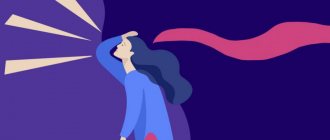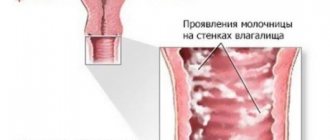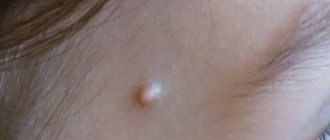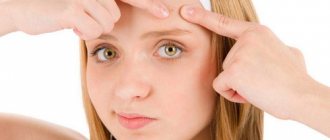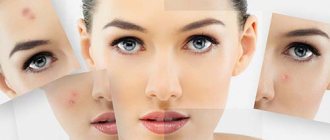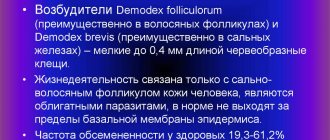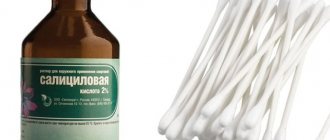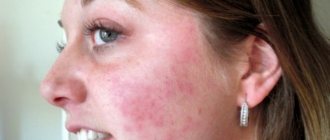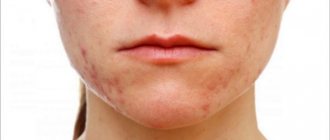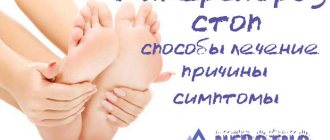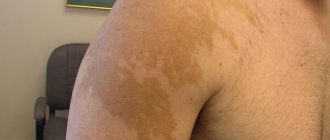Acne is a disease of the follicular apparatus of the skin. Today, it is one of the most common dermatoses in young women. And, despite the emergence of new effective treatments, the incidence rate continues to rise.
According to various studies, the proportion of women with acne at the age of 14-17 years is 80-85%, at the age of 25-40 years – 40-54%.
The severity of acne is influenced by many factors, but the root cause is hormonal imbalance.
Relationship
The theory that the skin reflects the condition of the entire organism is actively discussed in the popular literature. Today, specific disorders that lead to acne have been identified.
Back in 2011, clear research results were obtained that explained the relationship between hormonal levels and acne.
In 80% of cases, acne is a marker of dysfunction in the endocrine system of women. This means that only 20% of women have rashes that are not directly related to hormonal imbalances.
The skin is an important target organ for hormones. PG (sex hormone) receptors are located in the dermal structures, which respond to changes in the balance of these active substances.
The relationship between acne and hormones in women has been proven through clinical and laboratory studies. This topic has been actively researched over the past decade, since acne is a marker of women’s reproductive health.
Signs of hormonal imbalance: rash, acne and others
One of the clear signs of excess testosterone in the blood is the appearance of acne. This phenomenon is most often typical of adolescence. It is associated with changes in the physicochemical properties of the secretion of the sebaceous glands. Sebum becomes dense, clogs the ducts and creates conditions for the proliferation of bacteria.
In adult men, rashes can be a manifestation of dysfunction of the adrenal glands, thyroid gland and pituitary gland. Often, persistent acne is caused by the independent use of hormones from the group of steroids, somatotropin, by bodybuilders.
Signs of high testosterone levels also include:
- early puberty in boys (hair growth on the face, under the arms, in the perineum, rough voice, enlargement of the genitals), slower body growth;
- increased sexual desire;
- hair loss on the head;
- well-developed muscle tissue;
- increased appetite;
- aggressiveness, irritability.
Hair loss on the head
If such manifestations are not associated with the use of hormones in drugs, then their cause is most often dysfunction or tumor of the glands of the endocrine system.
Causes and mechanism of appearance
The mechanism of acne formation is complex and multi-stage. But, dermatologists and endocrinologists operate with sufficient data to effectively influence acne at different stages.
The mechanism of formation of hormonal acne:
- The ovaries or adrenal glands secrete excess androgens - male sex hormones. In response to the overproduction of androgens (testosterone), the level of estrogen - female PG - decreases.
- By reacting with insulin, testosterone turns into the active form dihydrotestosterone.
- Receptors are located in the skin, at the mouths of hair follicles, they respond to dihydrotestosterone and to a decrease in estrogen levels.
- Estrogen is responsible for maintaining hydrobalance and elasticity of the skin to prevent critical loss of moisture; receptors stimulate follicles to produce sebum.
- Sebum is synthesized to moisturize the skin, but does not have time to come out due to the thickness of the stratum corneum, so it gets stuck in the pores and forms sebaceous plugs - comedones.
- In the lipid environment of comedones, anaerobic bacteria begin to multiply, which, multiplying and colonizing the sebaceous ducts, cause pimples, acne, and cystic elements.
The anaerobic bacteria Propionibacterium acnes are joined by secondary pathogenic flora - streptococci and staphylococci, they aggravate the course of the inflammatory process.
What does hormonal acne look like?
Acne and hormones are closely interrelated, since the activity of the sebaceous glands and the condition of the hair follicles depend on the functional state of the endocrine system. Hormonal acne or pimples are localized in the upper back and face. They look like small inflammatory elements of several types:
- red nodular;
- light beige purulent;
- multiple ulcers.
With severe hormonal imbalances, conglobate acne occurs - grouped acne in the form of large cysts or nodules. After opening them, pigment spots or scars remain on the skin.
What hormones affect acne in women?
Hormonal levels are an unstable value. The concentration of these active substances varies depending on age and stage of the menstrual cycle.
PG levels are also affected by concomitant diseases, especially cancer, medications taken, lifestyle, bad habits, pregnancies and abortions in the past.
Acne is the main clinical marker of hyperandrogenism; dry skin that loses its elasticity are symptoms of estrogen deficiency.
The concentration of testosterone also affects the production of prolactin and progesterone, which are active in the second phase of the menstrual cycle and respond to the onset of ovulation.
Excess androgens
Hyperandrogenism is a hormonal disorder associated with increased synthesis of male PGs in the female body.
Androgens in the female body are produced by the ovaries and adrenal glands, but androgen receptors are located in the dermis and muscle tissue.
Hyperandrogenism, depending on its genesis, can be:
- ovarian (30%) , when the ovaries are responsible for testosterone hypersynthesis. In 90% of cases, it is accompanied by polycystic ovaries, which are easily diagnosed by ultrasound;
- adrenal in 8% , often accompanied by nephritis, kidney inflammation, and other urinary tract diseases;
- receptor in 12% , when the level of total testosterone is normal, but the susceptibility of skin receptors to androgens is increased;
- mixed 50% increased testosterone synthesis and increased receptor sensitivity.
In addition to acne, excess androgens have other symptoms, which are characterized by a general term - virilization or the appearance of male sexual characteristics.
External symptoms of hyperandrogenism:
- acne, oily seborrhea in androgen-dependent areas: forehead, T-zone on the face, chest, shoulders, back;
- hirsutism, the appearance of hair, according to the male type: on the face, chest, back, lower back, below the navel, etc.;
- seborrhea of the scalp, “greasy hair”, hair loss, even baldness, like in men (on the back of the head);
- increased sweating;
- change in body morphology, distribution of fat according to the male type: large belly and shoulders, but relatively slender legs; double chin, lack of waist, reduction in buttocks;
- small size of mammary glands.
Hyperandrogenism is especially dangerous because it affects the reproductive function of women.
If the pathology reduces fertility and the ability to conceive, it requires immediate treatment, as it can progress and cause androgenic infertility. Internal symptoms of hyperandrogenism:
- irregular menstrual cycle;
- severe, painful PMS;
- worsening acne in the 4th phase of the cycle;
- in severe cases, amenorrhea – absence of ovulation and menstruation;
- polycystic ovaries;
- underdeveloped uterus - hypoplasia, cervical insufficiency.
Depending on the type of androgenic pathology, a specific type of treatment is selected, but in 80% of cases complex therapy is required.
Insulin and insulin-like growth factor
Even if the blood sugar level according to test results is normal, the glucose tolerance test is satisfactory, patients with overproduction of testosterone are still at risk for developing type 2 diabetes. Insulin increases the formation of insulin-like growth factor and androgen production.
Increased insulin synthesis is also associated with obesity. And fatty deposits, in turn, are provocateurs of estrogen dominance. Here the main female hormone, estrogen, enters the arena.
Lack of estrogen and hypothyroidism
Increased production of androgens provokes a decrease in progesterone and estrogen - female hormones. But, in 30% of cases, with a large amount of androgens, peripheral estrogen production also increases. This forms a metabolic vicious circle, leading to polycystic disease, amenorrhea, and infertility.
Also, such estrogen dominance provokes hypothyroidism - insufficient intake of thyroid hormones into the body.
The compensation mechanism of estrogen hypersynthesis also provokes the formation of fibroids and endometriosis, and the appearance of malignant tumors.
The main reasons why hormonal imbalance occurs in men
The main male sex hormone (androgen) is testosterone. It is produced in the testes by Leydig cells. This process is controlled by the pituitary gland, and it in turn is stimulated or inhibited by the hypothalamus. Therefore, disease in any of these organs can cause sexual dysfunction.
A number of other hormones are involved in the regulation of androgen production by Leydig cells.
Hormonal levels are influenced by both the adrenal glands and the thyroid gland. Changes are also caused by improper functioning of the kidneys, intestines and liver, which are involved in the transformation and excretion of hormones. There are several groups of reasons that provoke disruption of the androgenic endocrine system.
Find out more about osteoporosis in men here.
Congenital diseases
The following have adverse effects on the fetus during intrauterine development:
- smoking, drinking alcohol;
- maternal viral infections, diabetes mellitus;
- irradiation;
- contact with toxic substances;
- food lacking protein and vitamins.
Hormonal imbalance can also be caused by genetic abnormalities inherited from parents. As a result, diseases arise that disrupt the process of puberty.
Delayed development is associated with:
- underdevelopment of the testicles;
- undescended (cryptorchidism) or abnormal location of the gonads;
- hereditary chromosomal abnormalities;
- disruption of sperm formation, male sex hormones, adrenal cortisol, thyroid thyroxine;
- resistance of tissues to the action of testosterone;
- decreased function of the pituitary gland or hypothalamus.
Early puberty in most cases is provoked by tumor diseases of the brain, adrenal glands, testicles, and genetic defects.
Acquired
A decrease in testosterone formation is associated with injuries, tumors, surgeries, and radiation therapy. Androgen deficiency also appears during infections, especially chronic inflammatory processes of the genitourinary system, and obesity. It happens as a consequence:
- meningitis, encephalitis;
- diabetes mellitus;
- stress;
- diseases of the thyroid and adrenal glands;
- mumps, measles;
- varicocele;
- vascular disorders, primarily atherosclerosis;
- age-related changes, loss of testicular activity during male menopause;
- chronic prostatitis;
- venereal diseases.
Toxic effects
The following have a damaging effect on the genitals:
- pesticides, nitrates;
- paints, solvents, household chemicals;
- nicotine, ethyl alcohol;
- cytostatics, hormonal drugs for long-term use;
- anabolic steroids used to build muscle mass.
Anabolic steroid
After taking antibiotics
Long-term use of antibacterial agents, especially from the tetracycline and macrolide groups, can lead to testicular dysfunction. Such conditions are reversible; they disappear on their own 2-3 weeks after the end of therapy. With a longer-term decrease in sexual desire and potency, consultation with a urologist and endocrinologist is required to rule out diseases.
What tests need to be taken
Primary diagnosis is carried out by external signs of virilization.
A woman with hormonal acne of 2-4 degrees is recommended to be observed by a dermatologist and gynecologist or endocrinologist.
Tests that need to be taken to confirm or refute hyperandrogenism:
- Blood sugar test + glucose tolerance test.
- Blood test for free testosterone levels. If this test is too expensive or not available in a particular region, the level of total testosterone is also an informative indicator.
- Ultrasound of the pelvic organs allows you to determine the type of hyperandrogenism. If polycystic ovary syndrome is detected, then GA is of ovarian origin.
- In some cases, an endocrinologist may prescribe a urine steroid profile and a biochemical blood test.
In fact, the first 3 tests and analysis of external symptoms are enough to make a diagnosis. Now, in the era of cooperation between doctors and private laboratories, thousands of tests have become popular. But, they are not absolutely necessary.
Treatment
It is recommended to begin complex therapy for hyperandrogenism only when, in addition to acne, other general symptoms of hormonal disorders are present (infertility, PMS, polycystic ovary syndrome, external signs of virilization).
The most effective treatments for hormonal acne are aimed at:
- reduction in the synthesis of male PGs - antiandrogenic drugs, oral contraceptives, plant estrogens, women's multivitamin complexes;
- preventing the transition of testosterone to the active metabolite dihydrotestosterone - low-carbohydrate diets, control of blood sugar levels, hypoglycemic drugs (Metformin);
- decreased sensitivity of skin receptors to androgens - Flutamide, Finasteride, Spironolactone;
- thinning the stratum corneum of the epidermis so that sebum can freely flow through the pores and come out - Tretinoin, Azelaic acid, Benzoliperoxide, Adapalene;
- suppression of bacterial flora to prevent the spread of the inflammatory process - Clindamycin, Syntomycin, Erythromycin.
Read how to make a mask against teenage acne at home. All about Acriderm for acne. More details here.
Drug therapy
Such a large-scale disruption of the endocrine system as hyperandrogenism, especially if it is aggravated by impaired glucose binding, estrogen dominance, obesity, acne and other symptoms of virilization, requires complex drug therapy.
Progestogen COCs are today considered the most effective and relatively safe group of drugs for the treatment of testosterone hypersynthesis.
On the pharmaceutical market, these drugs are known as combined oral contraceptives. Not all COCs have an antiandrogenic effect.
Birth control pills for treating hormonal acne:
- Preparations with gestagen - cyproterone acetate: Diane-35, Chloe, Dzhinette-35.
- Preparations with a gestagen - drospirenone: Yarina, Jess, Velmari, Drospifem, Fiminati, Fiona, Dariliya.
Drospirenone is a highly selective gestagen with an antiandrogenic effect. It is contraindicated in women with impaired renal and liver function, as well as a predisposition to thrombosis, but is generally well tolerated. Cyproterone acetate has more side effects and is therefore used less frequently.
COCs are a well-studied class of drugs; experienced gynecologists and endocrinologists operate with detailed research results and have detailed protocols for prescribing these drugs.
Spironolactone (Veroshpiron) is a potassium-sparing diuretic. It was used for decades for its main purpose until its side, antiandrogenic effect was discovered. In large doses, it is able to suppress the synthesis of androgens in the ovary. It has been proven that Spironolactone prevents the transition of testosterone to dihydrotestosterone.
The main disadvantage of drug therapy with birth control pills is a pronounced withdrawal syndrome and the reverse effect after stopping use, therefore it is recommended to supplement the complex treatment of hormonal acne with diet and herbal medicines.
Diet
The glycemic index diet should be the basis of the diet of women with symptoms of hormonal imbalance. It is necessary to avoid quickly digestible carbohydrates, sweets, especially sugary drinks.
White sugar can be replaced with natural or synthetic sweeteners: stevia, erythritol, aspartame.
Carbohydrates should be consumed only in slowly digestible forms: bran, whole grain bread, cereals. The basis of the diet should be vegetables, cereals, unsweetened fruits, proteins, lean meat, fish, eggs.
You should carefully study the products you buy, many contain hidden carbohydrates. Even seemingly healthy products are unsafe for women with hyperandrogenism.
Leaders in hidden carbohydrate content:
- fruit juices;
- breakfast cereals, cereals, instant porridges;
- yoghurts, curd desserts, sourdoughs, etc.
- marshmallows, dried fruits, candied fruits;
- sauces, especially ketchup, soy sauce, chili, teriyaki.
These products are especially harmful for women with hyperadrogenism and a predisposition to diabetes, because they are disguised as “healthy”.
In essence, the acne diet is a regular healthy diet, excluding sweets, baked goods, and hidden carbohydrates.
Herbal medicine and nutritional supplements
Herbal medicine, as a method of treating hormonal disorders, has received a new impetus for development in recent years.
Some phytocomplexes have proven effectiveness. And natural analogues of estrogens are even subject to state certification and are included in licensed drugs.
For example, new generation COCs.
Qlaira contains estradiol valerate, a natural analogue of synthetic ethinyl estradiol.
Herbal remedies with proven effectiveness for correcting hormonal imbalances:
- SawPalmetto or Sernoa is an extract of dwarf palm with a pronounced antiandrogenic effect; it prevents the transition of testosterone to its active form.
Preparations: “Prostamol Uno”, “Saw Palmetto” (dietary supplement) “Permixon”.
- Black cohosh, black cohosh or black cohosh provides a pronounced antiandrogenic effect and is a basic extract for the correction of menopausal symptoms in Europe.
Preparations: Cosimifuga-Homaccord, Altera Plus, PerFem Forte.
- Vitex or Prutnyak - the antiandrogenic effect is weaker, but Vitex, when taken for a long time, regulates the menstrual cycle, eliminates the imbalance between progesterone and prolactin, and is indispensable in the absence of ovulation.
Drugs: Cyclodinone, Mastodinone.
- Soy isoflavones - reduces the concentration of estrogen if it is increased, and increases it if it is decreased, reduces the level of androgens. It has been proven that Asian women who traditionally consume large doses of soy are less likely to suffer from androgenic disorders.
Preparations: soy-based dietary supplements, Doppelgerz Active Menopause.
Traditionally, fenugreek, evening primrose oil, mint, milk thistle, and pumpkin oil are also used to correct the hormonal levels of women; they are part of women's multivitamin complexes.
Skin care
Correction of hormonal disorders requires long-term therapy (up to 12 months), so it is important to use local medications for effective treatment of acne: ointments, creams, lotions.
Proper skin care helps accelerate and consolidate the success of complex drug therapy.
To even out skin tone, reduce the density of the stratum corneum, and prevent subsequent blockage of pores, it is recommended to use keratolytics and exfoliants.
Common medications for external acne treatment:
| Active substance | Drugs |
| Benzoyl peroxide | Baziron, Duak |
| Azelaic acid | Skinoren, Azik-Derm, Azogel, Acne-Derm, Aknestop. |
| Tretinoin | Retin A, Retino A, Airol, Vesanoid |
| Adapalene | Klenzit, Differin, Bezugrey, Ugresol, Effezel, Deriva |
Acid care also has a positive effect on skin condition. There are AHA and BHA lines in almost every cosmetic brand.
Products with glycolic, lactic, salicylic, ascorbic, mandelic, and citric acid have a positive effect on the condition of the skin. They even out the texture, remove acne, tighten pores, and even out the complexion.
It is recommended to pay special attention to serums with vitamin C, glycolic acid, enzymes, and home peels.
Preventive measures
You can preserve your beauty for a long time by following all the recommendations. What to do to prevent rashes from coming back:
- never squeeze pimples, especially with dirty hands;
- do not touch the skin or scratch with your nails (they contain a huge amount of bacteria);
- wash off decorative cosmetics, it is advisable to do this with special means;
- do not skimp on personal care; it is recommended to choose high-quality and proven face creams;
- refuse aggressive peelings and scrubs;
- get rid of bad habits, namely: quit smoking and drinking alcohol.
An active lifestyle, a healthy diet and proper skin care can relieve the disease for a long time. Very often, hormonal acne on the chin is confused with a rash from pollution. Surely, many people have noticed the habit of resting their heads on their hands while working. Don't forget about regular visits to doctors. If any disorders in the body are detected, you should contact a specialist and not self-medicate.
The condition of the skin, hair and nails is only an “indicator” of the health of the body. Acne, hair loss and other problems do not appear on their own, there are reasons for everything. It is foolish to try to disguise a defect or cure only a rash, without paying attention to the symptoms of serious diseases. Only an integrated approach will help you forget about the disease forever, preserving your beauty and health.
Prevention
The predisposition to hyperandrogyny in women cannot be predicted or prevented. The main causes of such disorders are genetics and malignant tumors. But habits and lifestyle also affect hormonal levels.
How to prevent hormonal imbalances that lead to acne?
- a healthy diet without the abuse of simple carbohydrates, as the main method of preventing type 2 diabetes and insulin-dependent hyperandrogenism;
- moderate physical activity, basic daily exercises to prevent congestion in the pelvic area (yoga, Pilates);
- regular visits to the gynecologist, taking care of women's health, monitoring blood sugar levels. The right approach to choosing contraceptives, without self-prescription. Some COCs based on Linestrenol and Levonorgestrel, on the contrary, stimulate the synthesis of androgens;
- using barrier methods of contraception rather than birth control pills during adolescence, when the endocrine system is still developing;
- preventive therapy with herbal remedies: mint tea instead of Americano, salad with pumpkin seed oil, women's vitamins in early spring.
Photo: Before and after
See which yeast to choose for acne. Baziron for acne. Find out further.
How to use jess for acne? The answer is here.
The female hormonal background is a fragile system; it requires constant care and attention. Androgenic disturbances of the endocrine balance in 80% of cases lead to pimples, acne and other aesthetic defects. But, with the right approach, treatment of hormonal acne can be successful.
